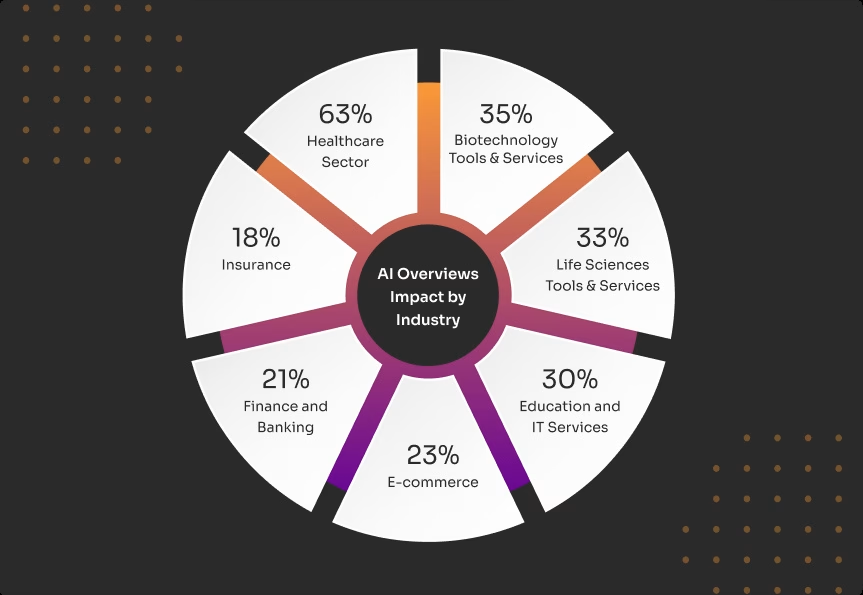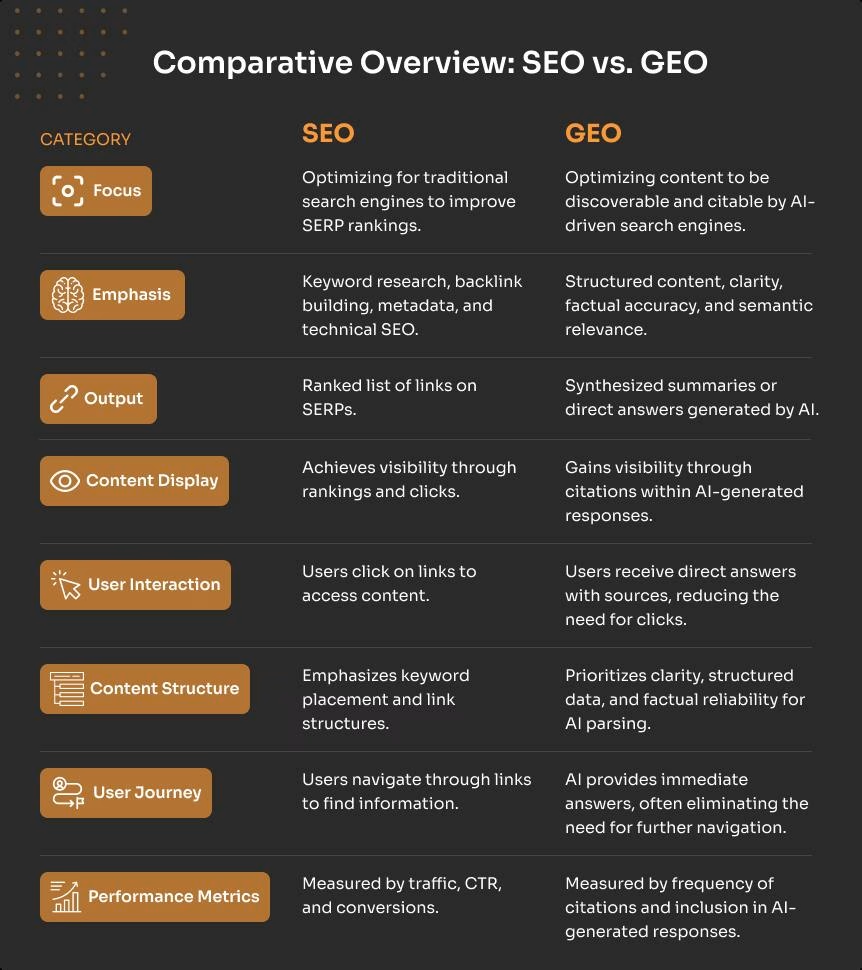
Everyone working in SEO right now can feel it – something big is shifting. Things are moving fast. The strategies that once defined search visibility: keyword targeting, link building, and technical site tweaks, are no longer enough on their own. With the rise of AI search and large language models (LLMs), the way people search, how engines respond, and how brands get discovered is being rewritten in real time.
At the center of this shift is something called Generative Engine Optimization, or GEO. GEO is the practice of optimizing content so it can be found, understood, and cited by AI-powered tools like ChatGPT, Perplexity, and Google’s Search Generative Experience (SGE). These tools don’t just list links – they generate direct answers using content from across the web. If your content is clear, factual, and well-structured, it might be what the AI chooses to include.
SEO has always required adaptability, but the shift to GEO raises the bar. This isn’t just another tweak to the algorithm. It’s a full-scale change in how people find information online. Users aren’t just browsing anymore, they’re asking questions and expecting instant, useful responses, often without clicking a single link.
GEO changes how we write, format, and structure content. Clients are seeing it too. It’s no longer just about climbing the rankings. It’s about showing up in the answers themselves. If you’re not building content that AI can pull from, you’re getting left behind.
Search is changing quickly. The smart move now is to understand how these new engines work and start creating content that fits the way they think. If your brand wants to stay visible and relevant, this is the moment to adapt.
Table of Contents
From Blue Links to AI Summaries: The End of Traditional SEO?
Search used to be simple. Type a keyword, get a list of links, click the one that looks best. That model is fading fast. Instead of sorting through search results, users now expect immediate answers – often pulled straight from AI-generated summaries.
This shift changes everything. It’s no longer just about getting your page to rank. It’s about becoming the source that AI tools like ChatGPT, Google’s SGE, or Perplexity rely on to generate those answers. To show up in this new kind of search, you have to understand how these models work and how they decide what to trust.
GEO (Generative Engine Optimization) Explained

Generative Engine Optimization (GEO) is the process of tailoring content to be effectively understood, selected, and surfaced by AI-powered engines – particularly those driven by large language models (LLMs) such as ChatGPT, Perplexity, and Google’s Search Generative Experience (SGE).
While traditional SEO focuses on improving a page’s position in search engine results pages (SERPs), GEO is about making content accurate, well-structured, and contextually rich enough to be referenced in AI-generated answers.
The key difference lies in the end goal: SEO aims to attract clicks by ranking higher on search results, while GEO aims to be the source that AI pulls from when generating responses. That means the content must not only be optimized for human readability but also for machine interpretation. In practice, this involves prioritizing clarity, factual accuracy, semantic relevance, and trust signals that LLMs recognize when assembling their answers.
What Is AI-Driven Search?

AI-driven search refers to search platforms powered by large language models (LLMs) that synthesize content into direct, conversational responses.
Tools like Google’s Search Generative Experience (SGE), Google’s AI Mode, Bing Copilot, and Perplexity AI use generative models to understand user intent and deliver highly contextual answers, often without requiring users to click through to a website. These engines prioritize meaning, relevance, and authority over traditional keyword density or exact-match phrasing.
Unlike traditional search engines that return a ranked list of links, AI-driven platforms aim to answer the user’s query in real time by pulling from multiple sources and presenting the information as a single, coherent summary. This is fundamentally changing how businesses approach search visibility today.
As a result, it’s more important than ever for brands to create content that is not only accurate and well-structured but also trustworthy and easy for AI systems to interpret and cite.
How Do Generative AI Engines Work?

If you’ve ever wondered how tools like ChatGPT come up with their answers in seconds, you’re not alone. Generative AI might seem like magic, but it’s actually the result of a powerful, structured process built on complex language models.
Let’s break it down into three key steps:
1. Training the Brain: How LLMs Learn to Speak Human
As mentioned, at the heart of generative AI are Large Language Models (LLMs). These models are trained on massive volumes of text – from books and websites to forums and research papers, so they can understand patterns in language, facts, and relationships. This deep learning gives them the ability to make educated predictions and generate relevant responses based on what you type.
2. Understanding You: How AI Makes Sense of Your Prompt
When you ask a question or give a prompt, the system doesn’t just look at the words – it tries to understand what you really mean. It breaks down your input to identify your intent and pick out the most important terms. This helps the model focus its attention on the most relevant areas of its training data.
3. Crafting the Answer: How AI Generates a Natural Response
Next, the AI scans through its internal “memory” of learned content to find the best information. It pulls together data from different sources, weighs the context, and then synthesizes it into a smooth, human-like response. That’s how you get an answer that sounds both informed and natural, almost like you’re talking to a knowledgeable friend.
How LLMs Are Reshaping Search Behavior?

Discoverability is being redefined, and search isn’t what it used to be. We’ve moved beyond clunky keyword strings and into an era of natural, conversational queries and LLMs are driving that shift. Thanks to generative AI, the way people search for and consume information has been completely transformed.
Search is no longer just about ranking – it’s about relevance and context. If you want to stay discoverable, your content needs to speak the same language users and AI are speaking.
From Keywords to Conversations
Traditional keyword-focused search – think “best digital cameras 2025”, is being replaced by intent-driven, conversational queries like, “What’s a good camera for travel photography under $1,000?” Users are no longer just plugging in keywords – they’re asking questions the way they would to a friend. It’s all about context and nuance.
How LLMs Respond Differently
LLMs are built to understand this shift. Instead of matching keywords to content, they interpret intent, understand context, and deliver personalized, highly relevant answers. This makes the old “10 blue links” approach feel outdated. Now, platforms like ChatGPT, Perplexity, and Google’s SGE serve up synthesized responses that skip the scroll and go straight to the point.
Adapting to the New Normal
As user behavior evolves, so must your content strategy. Instead of just optimizing for keywords, focus on clarity, context, and helpfulness. GEO is built to capitalize on this trend helping content show up directly in AI responses and driving visibility in a world where links matter less than answers.
Zero-Click Search Is the New Normal
If you’ve noticed fewer people clicking on your links, you’re not imagining it. More users are getting what they need directly from the search results, without ever leaving the page. These are called zero-click searches, and they’re becoming a regular part of how people interact with search engines, especially now that AI-generated answers are baked into tools like Google’s AI Overviews, Perplexity, and Bing Copilot.
In 2025, Bain & Company reported that around 80% of consumers rely on zero-click results in at least 40% of their searches. That’s leading to a 15–25% drop in traffic for many websites. Even back in 2024, SparkToro found that nearly 60% of Google searches ended without a click, and the trend hasn’t slowed since.
So what does that mean for you? Rankings still matter, but citations now matter more. If your content helps answer a question clearly and accurately, it has a shot at being pulled into an AI summary – whether you’re ranked first or not.
Instead of chasing blue links, start thinking about how your content can be the trusted answer AI chooses to display. That’s the goal of GEO: to make your content readable, reusable, and reliable – both for people and for machines.
Are Clicks Dead? Understanding GEO’s Impact on Traffic

LLMs and AI-driven search features like Google’s AI Overviews are significantly reshaping web traffic patterns, particularly affecting publishers and content creators. While overall search volumes remain stable, the way users interact with search results is evolving.
Recent studies indicate a substantial decline in click-through rates (CTR) when AI Overviews are present. For instance, Mail Online reported a 56% drop in CTR on desktop and a 48% decrease on mobile when AI Overviews appeared above their top-ranking search results. Similarly, BrightEdge observed a 30% year-over-year decrease in CTRs, even as search impressions increased by 49% .
This shift suggests that while visibility in search results has grown, the traditional path to website visits is narrowing. That’s because AI-generated summaries often satisfy user queries directly on the search page, reducing the need to click through to external websites. This trend is especially impactful for informational content, which is more likely to be summarized by AI features.
This raises an important question: Does Google still dominate search? The short answer is yes – Google remains the world’s most-used search engine, holding over 90% of global market share as of early 2025, according to StatCounter. But what’s changing isn’t who people search with, it’s how they search, and where they get their answers.
While Google isn’t going anywhere, competition from generative engines is growing fast. Platforms like ChatGPT, Perplexity, and Bing Copilot are increasingly serving as discovery tools delivering direct, citation-rich responses that bypass traditional search altogether. AI-powered summaries like Google’s own AI Overviews are already reshaping traffic patterns by answering questions directly in the SERP, reducing the need for users to click through.
Who’s Most Affected: Industries Hit Hardest by AI Overviews

AI Overviews are reshaping search behaviors across various industries, particularly those rich in informational content. Businesses in highly affected sectors should adapt their SEO strategies to ensure visibility within these AI-generated summaries.
Healthcare and Life Sciences
The healthcare sector is among the most affected, with AI Overviews appearing for 63% of its content. This high prevalence is due to the abundance of informational queries in this field. Similarly, biotechnology and life sciences tools & services see AI Overviews in 35% and 33% of their search queries, respectively.
Education and IT Services
Education services have AI Overviews triggered in 31% of their keywords, reflecting the sector’s focus on informational content. Conductor’s AI Overview study, which analyzed over 118 million real keywords, found that AI Overviews appear in about 30% of IT services-related searches—making it one of the most impacted industries after healthcare and education.
Finance and Banking
The financial sector experiences a moderate impact, with banking and financial services each seeing AI Overviews in 21% of their queries. This indicates a growing trend of users seeking quick, AI-generated answers in these areas.
E-commerce and Insurance
E-commerce content features AI Overviews in 23% of cases, while the insurance industry sees an 18% occurrence rate. These figures suggest that even transactional sectors are not immune to the influence of AI-generated summaries.
Industries with Lower Impact
Some sectors, such as real estate, automotive, and sports and recreation, currently experience lower AI Overview penetration. This may be due to the nature of queries in these industries, which often require more personalized or location-specific information.
SEO vs. GEO: What’s the Real Difference?
In the evolving landscape of digital search, traditional SEO has been the cornerstone for enhancing online visibility. SEO focuses on optimizing content to rank higher on Search Engine Results Pages (SERPs) through strategies like keyword research, backlink building, metadata optimization, and technical SEO. The primary goal has been to improve visibility, increase organic traffic, and convert users, with success measured by rankings, click-through rates (CTR), and conversions.
However, the advent of GEO marks a significant shift. GEO is tailored for AI-driven search engines that generate synthesized responses, such as Google’s Search Generative Experience (SGE) and BingChat. Unlike traditional search engines that list links, these AI engines provide direct answers, reducing the need for users to click through to websites.
This transformation necessitates a new approach to content optimization, focusing on making content discoverable and citable by AI.
Comparative Overview: SEO vs. GEO
By understanding and adapting to these differences, content creators and marketers can ensure their content remains visible and relevant in both traditional and AI-driven search landscapes.

Core GEO Strategies: How to Help AI Find, Understand, and Use Your Content
To show up in AI-generated answers, your content needs more than keywords. It has to be clear, structured, and trustworthy – ready for machines to read and reuse. GEO is all about making your content easy to discover, understand, and cite by large language models, not just humans.
Here are the core strategies that will help you get there:
1. Answer Real, Complex Questions Clearly
Write content that directly answers what people are asking, not just surface-level queries. Think beyond “what is” and dig into “why,” “how,” and “what’s best for…” types of questions.
2. Use Multiple Content Formats
Don’t rely on text alone. Mix in visuals, videos, infographics, or tables where appropriate. AI engines often pull content from multiple formats and favor content that’s easy to present in different forms.
3. Add Structured Data and Schema Markup
Using schema (like FAQ, Article, or HowTo) helps AI understand your content’s role and context. It’s a simple but powerful way to make your pages machine-readable.
4. Optimize for Entities and Semantic Depth
Mention related topics, people, places, tools, or concepts. These “entities” help AI connect the dots and better understand what your content is really about.
5. Include FAQs, Definitions, and Glossaries
These help answer common questions in a concise, structured way. AI models often pull directly from well-written FAQs and definitions when creating summaries.
6. Let User Behavior Shape Your Topics
Use search data, analytics, or on-site behavior to understand what people are actually looking for. GEO works best when your content aligns with real user intent.
7. Prioritize Clarity, Brevity, and Depth
Be concise but informative. Avoid fluff, but make sure your answers go deep enough to be genuinely helpful. Clear, well-structured content is easier for AI to cite.
8. Don’t Ignore Technical Optimization
Ensure your site loads quickly, is mobile-friendly, and uses clean, accessible code. Semantic HTML, fast performance, and proper headings all support AI comprehension.
9. Build Brand Authority Across the Web
The more your brand is mentioned, linked, and cited across trustworthy sites, the more likely AI is to treat your content as credible. GEO isn’t just about one page – it’s about your broader presence.
FAQ
1. Why Does GEO Matter?
Because generative engines are redefining how content is found and valued.
2. Is SEO Automatically GEO-Friendly?
No. GEO requires structure and clarity beyond traditional SEO.
3. Will GEO Replace SEO?
GEO complements rather than replaces SEO. SEO is evolving alongside GEO. Smart strategies combine both.
4. How Is GEO Impacting Local SEO?
Local sources gain traction in AI responses due to contextual accuracy.
Conclusion
GEO isn’t a future concept. It’s happening right now and it’s already reshaping how people find and consume information online. If your content marketing strategy is still centered only around ranking on Google’s SERPs, you’re missing how real users are getting answers today.
With AI tools like ChatGPT, Perplexity, and Google’s SGE delivering direct, citation-based answers, users often never click a single link. That means visibility is no longer just about being on page one – it’s about being the trusted source those engines rely on to generate their responses.
GEO doesn’t replace SEO. It builds on it. You still need strong site structure, clear writing, and keyword awareness. But now, you also need to think about how AI models read, understand, and reuse your content. If you want your brand to stay visible in this new search landscape, now is the time to adapt.
In the next article, we’ll break down how to do exactly that with actionable strategies, tools, and techniques to make your content discoverable, citable, and AI-friendly.

